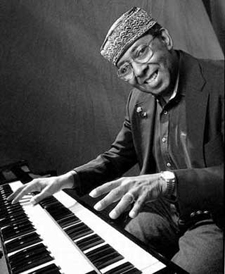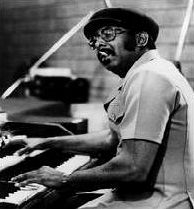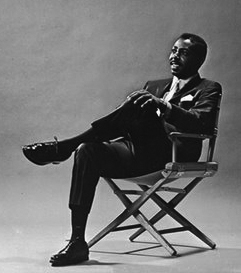James Harrell McGriff
 James Harrell McGriff was born on April 3, 1936, in Philadelphia, Pennsylvania, birthplace of many of jazz’s greatest organists. He started playing piano at the age of five and by his teens, was also playing alto sax and upright bass. His first group was a piano trio, which found him playing bass in the band. When he joined the U.S. Army, McGriff served as an MP in Korea and settled in on a career as police officer for Philadelphia’s finest, a gig which only lasted a little more than two years.
James Harrell McGriff was born on April 3, 1936, in Philadelphia, Pennsylvania, birthplace of many of jazz’s greatest organists. He started playing piano at the age of five and by his teens, was also playing alto sax and upright bass. His first group was a piano trio, which found him playing bass in the band. When he joined the U.S. Army, McGriff served as an MP in Korea and settled in on a career as police officer for Philadelphia’s finest, a gig which only lasted a little more than two years.
Music kept drawing McGriff’s attention away from the police force. His childhood friend, organist Jimmy Smith, had begun earning a substantial reputation in jazz for his Blue Note records (the two played together once in 1967) and McGriff became interested in the organ sound while Richard “Groove” Holmes played at his sister’s wedding. Holmes went on to become McGriff’s teacher, friend and, on two occasions in 1973, his sparring partner for two Groove Merchant records.
In April 1960, McGriff made the switch and started playing organ. He was greatly influenced by the energy and dynamics of organist Milt Buckner and the diplomatic aplomb of Count Basie. But such local pianists as Sonny Gatewood, Howard Whaley and Austin Mitchell held his favor too. McGriff formed a combo that played around Philadelphia and often featured upcoming tenor sax player, Charles Earland, who soon switched permanently to organ when he saw how much fun McGriff was having at the organ. During this time, McGriff also accompanied such artists as Don Gardner, Arthur Prysock, Candido and Carmen McRae who came through town for local club dates.
In 1961, McGriff’s trio was offered the chance to record an instrumental version of Ray Charles’s hit I’ve Got A Woman by Joe Lederman’s Jell Records, a small independent label. When the record received substantial local airplay, Juggy Murray’s Sue label picked it up and recorded a full album of McGriff’s trio, released in 1962. The album also turned out another huge hit, “All About My Girl,” firmly establishing McGriff’s credentials as a fiery blues-based organist, well-versed in gospel soul and fatback groove.
McGriff recorded a series of popular albums for the Sue label between 1962 and 1965, ending with what still stands as one of his finest examples of blues-based jazz, Blues For Mister Jimmy. When producer Sonny Lester started his Solid State record label in 1966, he recruited Jimmy McGriff to be his star attraction. Lester framed McGriff in many different groups, performing a wide variety of styles and giving the organist nearly unlimited opportunities to record. McGriff was heard everywhere; from an all-star tribute to Count Basie (The Big Band), a series of “Organ And Blues Band” records (of which, 1969’s A Thing To Come By, is the best), pop hits (Cherry, The Way You Look Tonight) and funk classics (Electric Funk and such singles as The Worm and Step 1).
During this time, McGriff actively performed at clubs and concert halls worldwide. He settled in Newark, New Jersey, and eventually opened his own supper club, the Golden Slipper – where he recorded BLACK PEARL and a live album with Junior Parker in 1971. Beginning in 1969, he also performed regularly with Buddy Rich’s band, though the two were only recorded once together in 1974.
McGriff “retired” from the music industry in 1972 to start a horse farm in Connecticut. But Sonny Lester’s new record company, Groove Merchant, kept issuing McGriff records at a rate of three or four a year. By 1973, McGriff was back – touring relentlessly and actively recording again. Around this time, disco was gaining a hold in jazz music and McGriff’s flexibility proved infallible.
By 1980, McGriff broke away from Sonny Lester and began working actively with producer (and former funk lord) Bob Porter (and recording master Rudy Van Gelder). McGriff began a long relationship with Fantasy’s Milestone label, which has caught him in a wide variety of circumstances featuring such headliners as Rusty Bryant, Al Grey, Red Holloway, David “Fathead” Newman, Frank Wess and young gun Eric Alexander.
Between 1994 and 1998, McGriff also experimented with the Hammond XB-3, a sort of synthesized organ that increased the organ’s capabilities with MIDI enhancements. This gave McGriff an unnatural synthesized sound, which probably explains his retreat from the instrument on such recent efforts as 2000’s funky McGRIFF’S HOUSE PARTY (featuring fellow organist Lonnie Smith). He is a considerable player of many abilities and has managed over four decades to appeal to a diverse audience of listeners.

